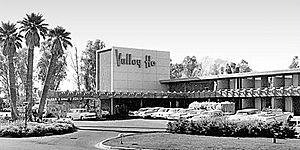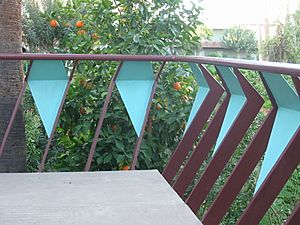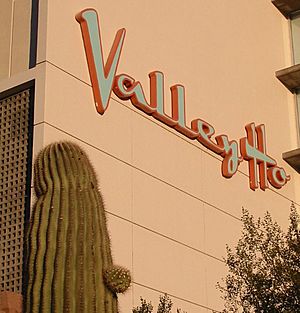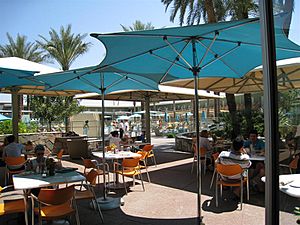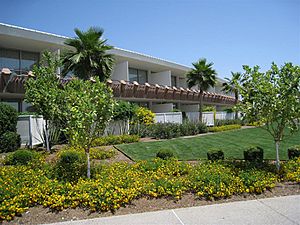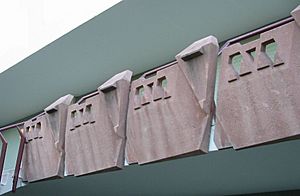Hotel Valley Ho facts for kids
| Hotel Valley Ho | |
Quick facts for kids 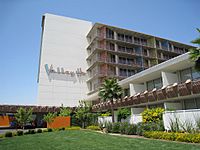 Hotel Valley Ho |
|
| Hotel facts and statistics | |
|---|---|
| Location | 6850 East Main Street, Scottsdale, Arizona |
| Coordinates | 33°29′37″N 111°56′0″W / 33.49361°N 111.93333°W |
| Opening date | December 20, 1956 |
| Architect | Edward L. Varney (1956) Allen+Philp (2005) |
| Management | Westroc |
| No. of restaurants | 1 |
| No. of rooms | 194 |
| Total floor area | 220,000 square feet (20,000 m2) |
| No. of floors | 7 |
The Hotel Valley Ho is a famous hotel in Scottsdale, Arizona. It's also known as the Valley Ho. For 28 years, it was called the Ramada Valley Ho. The hotel was first designed by Edward L. Varney. He was a student of the well-known architect Frank Lloyd Wright.
The Hotel Valley Ho opened in 1956. It had a very modern and futuristic design for its time. Many movie stars and famous baseball players stayed there. The hotel quickly became known for its stylish guests and trendy atmosphere. Because it was so popular, the hotel expanded in 1958. Two new sections of guest rooms were added.
In 1973, the Ramada hotel chain bought the property. They redecorated the hotel to hide its 1950s look. At the time, this style was seen as old-fashioned. Even though it wasn't as trendy, the hotel was still in a great spot. It hosted many meetings and welcomed vacationers for years. However, under Ramada, the hotel started to look a bit run down. Its popularity slowly faded. It closed in 2001. People even thought about tearing it down because no one wanted to buy it.
But many people loved the hotel's special architecture and its history. They worked hard to save it. The hotel was then placed on the Scottsdale Historic Register. This protected it from being destroyed.
In 2002, Westroc Hotels & Resorts bought the hotel. They started a big renovation project. It was finished in 2005. The architectural firm Allen+Philp redesigned the hotel. They added a seven-story tower with rooms and condos. This tower was inspired by Varney's original idea. New restaurants were also added, like ZuZu. The hotel's original "jet-age" design was brought back as much as possible. It was also updated with modern features from the 2000s.
The Hotel Valley Ho has won the AAA "Four Diamond Award". It is also part of "Preferred Hotels & Resorts". Architect Alan Hess called the hotel "one of the best-preserved mid-century hotels in the country."
Contents
Hotel History and Design
The idea for the Hotel Valley Ho came from Robert and Evelyn Foehl. Robert Foehl had worked at the Biltmore Hotel in Los Angeles, California. He then managed the Jokake Inn in Scottsdale. Evelyn Foehl was one of the few women in the hotel business. She managed the Hacienda del Sol in Tucson, Arizona.
The Foehls gathered investors to build a new hotel. They chose an 8.86-acre (3.59 ha) site in Scottsdale. They hired Edward L. Varney, a leading local architect. Varney designed the hotel around a central pool lounge. He used long, horizontal lines in the room sections. These rooms had air conditioning, which was new for Scottsdale. This meant the hotel could stay open all year.
A curving entrance, called a porte-cochere, led to a tall lobby. This lobby gave guests a grand "sense of arrival." This was a feature often used by Frank Lloyd Wright. The lobby connected guests to a restaurant, a lounge, a nightclub, and the main pool. The inside of the hotel was designed by Thelma Hawkins. Construction was finished on December 20, 1956. It cost $1.5 million, which is like $16.1 million today.
Varney also added a parking lot, which was unusual for hotels back then. Guests could park their cars very close to their rooms. This made it the first "motor resort" in Scottsdale.
Naming the Hotel Valley Ho
In March 1956, the Foehls held a contest to name the hotel. They wanted a name with a "westward flavor." It should be like their other hotel, the Westward Ho in Phoenix. The winning name was "Valley Ho." This was because the hotel was near Paradise Valley. The "Ho" part connected it to the older hotel in Phoenix. Later, they found out that "ho" means "you are welcomed here, this is a friendly place" in a local Native American language.
Famous Guests and Popularity
The Foehls knew many people in the Hollywood film industry. Many film stars stayed at the hotel. In 1957, Robert Wagner and Natalie Wood had their wedding reception there. Other famous guests included Bette Davis, Roy Rogers, Bing Crosby, Frankie Avalon, Humphrey Bogart, Betty Grable, Janet Leigh, Marilyn Monroe, Zsa Zsa Gabor, Ingrid Bergman, Cary Grant, and Tony Curtis. Sometimes, Jimmy Durante would play the piano in the lounge late at night. The Foehls lived at the hotel and managed it very closely.
The company Motorola used the hotel to house employees who moved to the area. Many baseball players and coaches also stayed there during spring training. These included Joe DiMaggio, Ted Williams, and Leo Durocher. Leo Durocher always asked for Room 103 because it was close to the lobby. A sports reporter named Dave Hoekstra said the Valley Ho was the "high-roller place" in the Sun Valley during the 1960s.
The Valley Ho was very popular, competing with the Safari Hotel. Both hotels offered great service. They helped Scottsdale become a well-known tourist spot. Because the Valley Ho was so successful, Varney designed two more sections of rooms in 1958. These new parts used the same materials and style. Another famous Scottsdale hotel, the Mountain Shadows Resort, opened in 1959. These hotels helped Scottsdale feel like a fancy and exciting place.
Hotel Renovation and Revival
In 1973, Robert Foehl passed away. Evelyn Foehl then sold the hotel to Ramada. The Ramada managers redecorated the hotel. They removed or covered many of the original 1950s designs. The hotel was renamed Ramada Valley Ho. It stayed popular for a while, but its original charm was gone. It also started to suffer from a lack of care.
The hotel continued to host meetings until 2001. Later that year, it closed and was put up for sale. Since no one wanted to buy it, there were plans to tear it down. To save it, Alan Hess wrote a letter explaining its importance. A successful effort was made to get it listed on the Scottsdale Historic Register. This recognized its value to the city's history and architecture.
To save it from being torn down, Scott Lyon and Bill Nassikas bought the hotel. They were business partners from Westroc Hotels & Resorts. They started a huge renovation and added new buildings. This project cost $80 million. Evelyn Foehl passed away in 2003, two years after the hotel closed for renovation.
The architectural firm Allen+Philp took on the renovation. They researched the hotel's history. They found that Varney had originally planned a tower of guest rooms above the lobby. This tower was never built. Allen+Philp designed a seven-story tower. This helped the new owners make the hotel more successful. Architect Mark Philp said they tried to "stay true to the spirit of the original." The interior designer, Cole-Martinez, updated the decorations. They mixed modern touches with hints of the past. Reporter Dave Hoekstra was happy that the renovation kept the original "Jetsons-in-the-desert flavor." The hotel re-opened on December 20, 2005. This was exactly 49 years after its first grand opening.
Hotel Features and Services
The Hotel Valley Ho has one restaurant. It offers many guest rooms and suites. There are also over 30 luxury condominiums for people who live there permanently. These condos are between 1,450 to 2,400 square feet (135 to 223 m2) in size. The hotel is only a 15-minute drive from Phoenix Sky Harbor International Airport. It's also close to Arizona State University.
The Hotel Valley Ho won the "Four Diamond Award" from AAA every year from 2007 to 2009. In 2006, it joined Preferred Hotels and Resorts. The Valley Ho is one of the top-ranked hotels in Scottsdale on TripAdvisor.com. It even ranks higher than the famous five-star Phoenician Resort. One reviewer said, "Don Draper would approve," referring to the TV show "Mad Men," which takes place during the hotel's early popular years.
Dining and Rooms
ZuZu is the hotel's restaurant, located in the main lobby. It serves seasonal American food. Executive Chef Charles Wiley compared the restaurant's renovation to rebuilding an "old Harley-Davidson." New features were added while keeping vintage ones. Food and drinks are also served at the OH Pool Bar + Cabanas.
The hotel has 21 large studio rooms. Their bathrooms are separated by a curtain. Eleven cabana rooms overlook the pool and have large patios. There are also two executive suites and three terrace suites. These suites include an 800-square-foot (74 m2) balcony or patio.
Since its renovation, famous people like Jamie Foxx, Eddie Van Halen, and the band Korn have stayed at the hotel. Robert Wagner has also returned to visit.
Hotel Architecture and Style
The Hotel Valley Ho is a great example of the mid-century modern architectural style. Varney used materials like masonry, concrete, natural stone, and large glass windows. This made the building feel connected to its surroundings. Stone patterns on the floor and walls link the outside entrance to the lobby. The redwood ceiling also extends from outside to inside. The hotel is now seen as one of the best examples of organic architecture.
The rooms in the two sections added in the late 1950s are special. They have high nine-foot ceilings. This was very forward-thinking for the time. Most rooms back then had lower ceilings, sometimes only seven feet high. But the Valley Ho's rooms feel very spacious and airy because of this design choice.
The hotel features repeating horizontal rows of V-shaped red concrete forms. These look like abstract arrowheads. These precast forms give the building a subtle "Southwestern" or "American Indian" feel.
During the renovation, old walls and coverings were removed. This revealed the original 1950s features. Drywall was taken off guest room walls to show the original brickwork. Walls in the central lobby were torn down. This opened up the space, connecting the indoor and outdoor public areas as Varney intended. Concrete columns in the lobby were stripped of mirrors added by Ramada. This showed their original design.
The hotel offers a 90-minute architectural tour. Experts from Ultimate Art & Cultural Tours of Scottsdale lead these tours by appointment. The tour focuses on the hotel's design and its Hollywood past. It includes a look inside some restored rooms, a walk around the grounds, and a stop at the Sky Line Rooftop. From there, you can see amazing views of Phoenix and Scottsdale.


